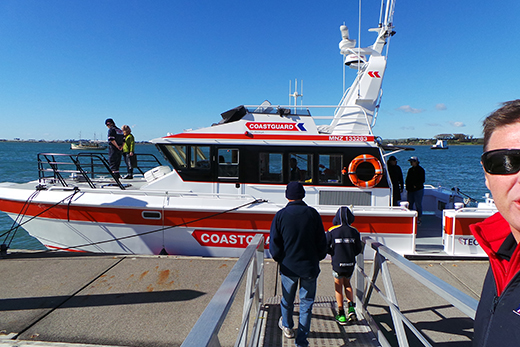One of the missions facing Tauranga Volunteer Coastguard unit manager Steve Russel during the next few years is beginning the process that will see the eventual replacement of the current rescue boat, named TECT Rescue.
“We’re at the very early stages at this point, it’s a four to five- year strategy to replace the big boat,” says Steve.
There’s two stages to the plan. The fundraising project and the boat project. Steve’s looking at a five-year plan, describing how they go about it; and then deciding what is the best boat to fit the Bay of Plenty area and its growth.
“That’s going to be a project in its own right,” says Steve. “We are just getting involved, and trying to get some ideas.
Tauranga’s hard working TECT Rescue, a 13m Robson powercat.
“Coastguard New Zealand is quite keen on getting a fleet that are all the same, but that’s part of their strategy. At this stage we have just got to get on and plan what we need to do locally,” says Steve.
“Obviously, if you do end up having a larger Coastguard New Zealand strategy they may be able to supply boats at a much better rate because they will be able to supply more over a longer period.
“It’s going to be a pretty busy year getting the strategy document prepared during the next six months, and from there having an idea what is required and from there going to the local community and the people that are going to help pay for it.”
The current Auckland Coastguard boat is LION Foundation Rescue, a -speed foil assisted catamaran designed by Nic de Waal of Teknicraft Design Auckland, New Zealand, and built in Whanganui by Q-West Boat Builders.
LFR is an aluminium, live aboard, multi SAR mission capable vessel, designed to operate in the greater Hauraki Gulf out of its base at the Marine Rescue Centre, Mechanics Bay, Auckland.
Their operating style is different to Tauranga’s, says Auckland coastguard general manager Duthie Lidgard. Weekend crews live onboard. A crew of four to six stays on board – which with accommodation and services means an all-round bigger boat than a day-tripper like the Tauranga TECT Rescue boat.
“We have so many people out there overnight, it’s nice to be there anchored with them and if somebody is in trouble we are right there,” says Duthie.
“All the accommodation we put in them is not suitable for a lot of other people – and adds to the cost. And the weight and the size.
“Probably they [Tauranga] don’t need something quite as big, but it depends on the work they are getting – because the work here is getting bigger and bigger. Nobody’s buying smaller boats, they are all buying monsters.”
LFR’s cruising speed is 28 knots, with a top speed in excess of 40 knots depending on conditions.



0 Comments
Leave a Comment